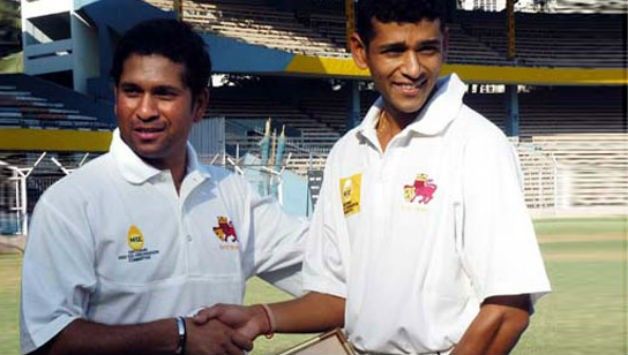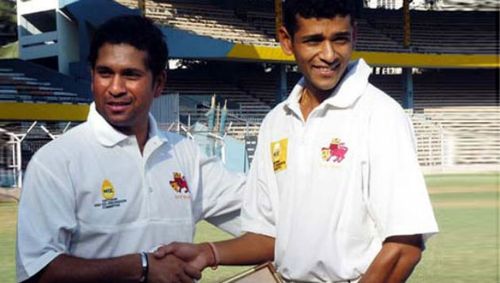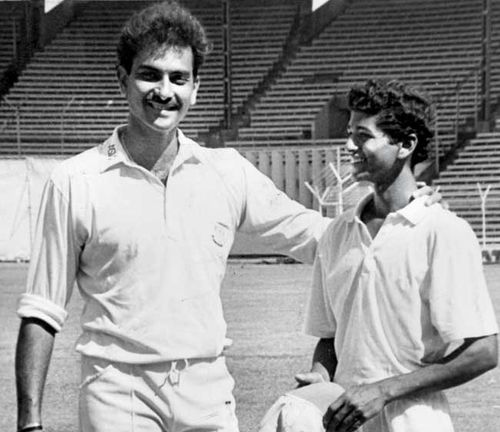
Amol Muzumdar: The tragic story of India's 'next Sachin Tendulkar' who faded into oblivion

On a bright spring morning, two young boys were scripting history. One of them would go on to be heralded by most as the greatest batsman of the modern era; the other was to sparkle briefly before fizzing out. The match in question pitted Shardashram Vidya Mandir against St. Xavier's in the semifinals of the 1988 inter-school Harris Shield tournament, and the boys at the crease were Sachin Tendulkar and Vinod Kambli, who were in the process of stitching together a world record partnership of 664 runs for the third wicket.
While this story is very popular, little is known about the batsman slotted to come in next; a 13-year-old boy named Amol Muzumdar. Padded up ever since the first wicket fell, Muzumdar waited in the wings for the entire duration of the remainder of the innings; he kept practicing in the nets, and every time he checked, he saw the two continue their onslaught on the hapless bowlers. When Shardashram finally declared their innings on a colossal 748, Tendulkar and Kambli were still unbeaten, and Muzumdar’s pads came off without a stroke in the middle. This wait is perhaps symbolic of the never-ending wait of the talented Mumbaikar to break into the national team, something he never managed to achieve.
Record-breaking Ranji Trophy debut
Making his first class debut in the 1993-94 Ranji Trophy pre-quarter-final against Haryana, Muzumdar struck a magnificent 260, breaking the world record for the highest score made on first-class debut, which till then was held by Transvaal's W. F. E. Marx, who made 240 against Griqualand West in Johannesburg in 1920-21. Muzumdar’s record stands till today.
The scintillating debut, followed by a string of consistent knocks, saw the young Muzumdar being hailed as the ‘next Sachin Tendulkar’, and was soon drafted as the vice-captain of India Under-19 squad. His perfect technique and calm demeanor saw him getting pitted against another rising youngster with similar qualities – Karnataka’s Rahul Dravid. The selectors got an opportunity to watch both these talented youngsters on a common platform during the England A tour of 1995, which included 3 unofficial Tests and 3 one-day games.
The visitors crushed the India A side 3-0 in the longer format, and Muzumdar failed. Dravid, even back then, stood rock steady while almost everyone perished around him. Muzumdar bounced back in the ODI series, which again the visitors took 2-1, with scores of 79 and 69 in the first two matches, but he had lost the contest against Dravid, considered largely on the basis of performances in the longer format. Another youngster who was part of that A team, Sourav Ganguly, had a forgettable series across both formats.
The 1996 tour of England was a crucial one for these young guns, with two stalwarts looking set to exit the Indian Test arena – Navjot Singh Sidhu and Sanjay Manjrekar. The 1995-96 Duleep Trophy was the most likely feeding ground for these replacements, and the stage was set for four talented batsmen – Rahul Dravid, Sourav Ganguly, VVS Laxman and Amol Muzumdar, to prove their worth to the selectors.
Laxman topped the batting charts, with 395 runs, and was followed by Dravid with 353 runs. Muzumdar was not far behind, on 4th position, with 333 runs, including an imperious double century against North Zone. Ganguly rounded off the quartet, finishing 6th with 308 runs.
Born in the wrong generation
While the selectors were not yet convinced about Laxman’s consistency, Dravid was an automatic choice. The toss-up for the final spot may have been between Muzumdar and Ganguly; though the latter had lesser runs, his innings of 171 against a very strong West Zone bowling attack may have helped in getting a nod in his favor. This was perhaps Muzumdar’s best chance of getting into the national Test squad – but nobody can complain about the people who got in at his expense – Ganguly went on to crack consecutive centuries in his first two Test matches, and with Dravid displaying the perfect combination of technique and temperament right from the onset, India had just discovered two of its greatest Test batsmen.
The man who put cricket above everything else – in an interview, Muzumdar confessed that he never had outings with family or friends, and did not even celebrate his birthdays – continued piling runs for Mumbai in the Ranji Trophy. Between 1993-94 and 2002-03, he scored 6051 runs in 90 matches at an average of more than 50. During this period, he saw Mumbai teammates like Wasim Jaffer, Sairaj Bahatule, Nilesh Kulkarni etc. (the first, definitely deserved, the others, a result of India’s unsettled bowling order) getting into the national side, without ever getting a call himself.

Perhaps his greatest enemy was his batting position – he preferred batting at numbers 3 or 4 – positions which were made their own by Dravid and Tendulkar respectively. The number 5 position did present a few opportunities, with a young Laxman, reminiscent of a modern Rohit Sharma, combining high octane innings like his 167 against Australia in Sydney 1999-00 with several disappointing ones.
The 2001 Test match against Australia at Kolkata changed all that, and he went on to become one of India’s most valuable Test players over the next decade. Ganguly was also criticized often for his lack of footwork and susceptibility against short-pitched bowling outside the sub-continent, but he kept scoring runs, and post captaincy, his excellent leadership skills made him a permanent fixture in the Indian Test squad. So, with nobody but time to blame, Muzumdar really did not stand a chance to break into the Indian Test middle-order during the peak of his batting abilities.
Into the twilight of his career
The beginning of the end, though the writing on the wall was evident much earlier with respect to getting into the national side, came in 2009, when he was dropped from the Mumbai team for the Buchi Babu tournament. He retaliated by deciding to join Assam for the upcoming domestic season where he led from the front, helping them get promoted to the Elite division the very first year. However, the happiness was short-lived, and they were relegated the very next year. He then re-applied to the Mumbai team, only to be informed that a ‘cooling-off’ period of one year was in place, possibly due to his unceremonious exit in 2009.
In an increasingly worrying sign of departure from the calmness which graced his batting during his hey-day, Muzumdar, at the end of the ‘cooling-off’ year, signed up, not for Mumbai, but for Andhra Pradesh! However, his cricketing acumen appeared intact, as he scored close to a 1000 runs for Andhra in the 2012-13 Ranji season, at an average of nearly 80, emerging as one of the top run-scorers in the tournament.
Muzumdar continues to play first-class cricket, but his dream of representing the country at the highest level is not likely to be realized. With more than 9200 runs, he is the second highest run scorer of all-time in the Ranji Trophy, just behind his former Mumbai teammate Wasim Jaffer. It is a shame that such pedigree went unnoticed at an international level, and today, after his nomadic ventures over the last 5 years, he may even have faded from the memory of many of his beloved Mumbaikars, with the new batch of ‘next Tendulkars’ like Rohit Sharma and Ajinkya Rahane emerging.
The man did no wrong, but for the fact that he was at his peak in an era dominated by the ‘Big 4’ in Indian cricket. Had he been around today, as the young boy who gave three of India’s best cricketers a run for their money in the 1994-95 Duleep Trophy, he would have been a definite presence in the current tattered middle-order; but unfortunately, at a shade below 40 years of age, he will not be in contention now.
His story may be forgotten as one among several talented sportsmen, who failed to breakthrough at the highest level in their individual sport, but he does deserve a silent applause for sheer commitment to the game for more than two decades, a one-sided love affair which will end as one of the most tragic romances in cricketing history.